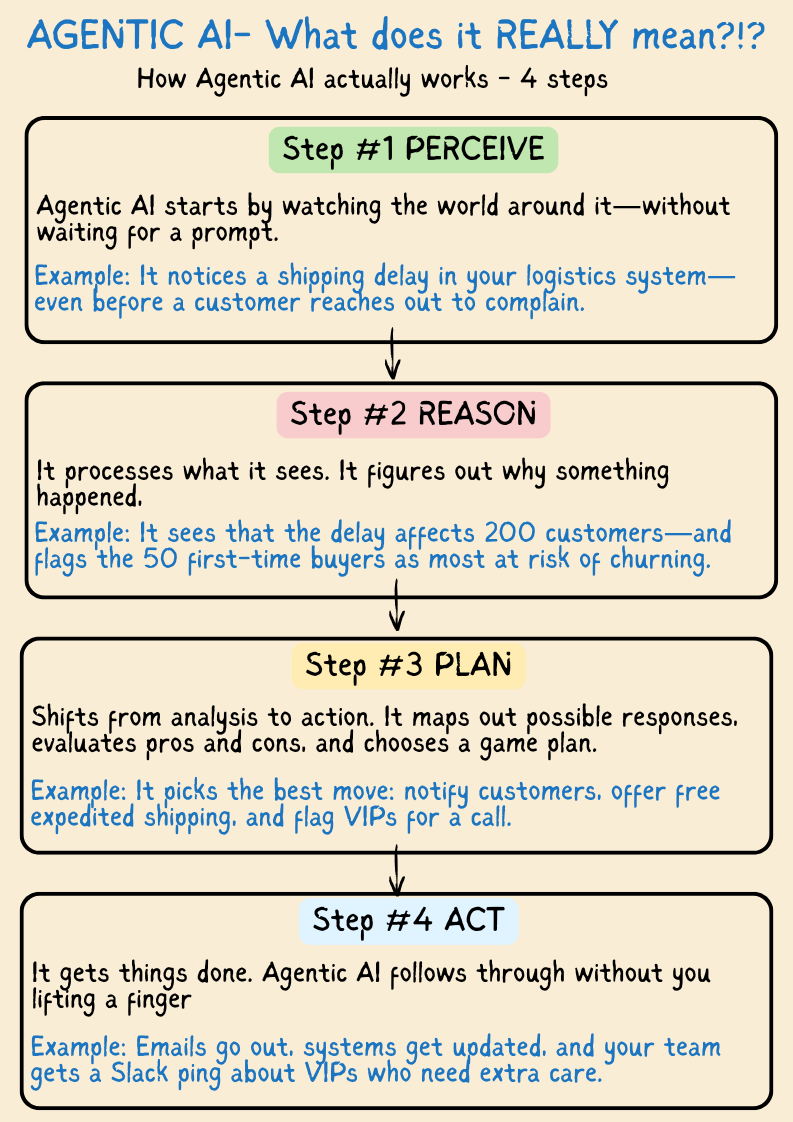From Chatbot to a Personal Assistant: What Actually Makes AI Agents Truly "Agentic"
Agentic AI is the buzzword everyone's using but nobody can quite explain. Learn what makes AI agents truly autonomous—and how they can transform your workflows.
A big thank you to this edition’s sponsor—Superhuman AI
Find out why 1M+ professionals read Superhuman AI daily.
In 2 years you will be working for AI or an AI will be working for you
That's why 1M+ pros working at Google, Meta & OpenAI read Superhuman AI. Join now & learn AI skills, the latest AI tools & news in just 3 minutes a day.
Everyone's talking about "agentic AI" like it's the next iPhone moment for software. It's in pitch decks, boardrooms, product launches. But if you're being honest, you're probably thinking: "Isn't this just ChatGPT with a fancier name?"
Let me clear this up once and for all.
Why This Matters Right Now
Agentic AI isn’t just another buzzword—it's shaping up to be 2025’s biggest AI disruption.
Enterprise adoption is estimated to jump from less than 1% today to 33% by 2028. But here's the kicker: most people still don't get what it actually does.
And that misunderstanding? It's costing you—time, leverage, and relevance. While others are already plugging agentic AI into their workflows and freeing up hours of mind-numbing busywork, you're still stuck Googling what the term even means.
Ignore it, and you'll fall behind. Understand it now, and you're early.
The Simple Truth: It's About WHO Takes Action
Traditional AI (like ChatGPT) is reactive. You ask, it answers. You prompt, it responds. You're always in the driver's seat.
Agentic AI is proactive. It observes, plans, and acts—often without you asking.
Think of it like this:
Traditional AI = A really smart calculator that waits for your input
Agentic AI = A personal assistant who notices your calendar is packed, automatically reschedules non-urgent meetings, and sends you options for the rest
How Agentic AI Actually Works: The 4-Step Dance
Every agentic AI system follows the same basic process. Here's how it breaks down:
1. Perceive (Gather Information)
Agentic AI starts by watching the world around it—without waiting for a prompt. It scans emails, data feeds, user activity, calendars, app usage, and more. While traditional AI sits idle until asked, agentic AI stays alert, constantly soaking up new signals.
Example: It notices a shipping delay in your logistics system—even before a customer reaches out to complain.
2. Reason (Understand What's Happening)
Now it processes what it sees. This isn’t just matching a pattern or keyword. The AI figures out why something happened, who it impacts, and how urgent it is. It weighs tradeoffs just like a smart teammate would.
Example: It sees that the delay affects 200 customers—and flags the 50 first-time buyers as most at risk of churning.
3. Plan (Decide What to Do)
The AI shifts from analysis to action. It maps out possible responses, evaluates pros and cons, and chooses a game plan. This is what makes it feel intelligent—not just spotting a problem, but deciding what to do next.
Example: It picks the best move: notify customers, offer free expedited shipping, and flag VIPs for a call.
4. Act (Execute the Plan)
Last step: it gets things done. Agentic AI follows through without you lifting a finger—sending emails, editing records, or alerting teammates. And when a decision is too risky? It taps you in.
Example: Emails go out, systems get updated, and your team gets a Slack ping about VIPs who need extra care.
What This Looks Like in Your Daily Work
For Content Creators: Instead of manually checking analytics and planning content, an agentic AI notices your engagement is dropping, analyzes what's working for similar creators, and suggests three content pivots with drafts ready for your review.
For Product Managers: Rather than constantly monitoring user feedback, the AI detects a spike in feature requests, cross-references them with your roadmap, identifies quick wins, and drafts PRDs for your engineering team to review.
For Marketing Teams: Instead of reacting to campaign performance, the AI spots an underperforming ad, tests alternative messaging, reallocates budget to better-performing channels, and sends you a summary of what it changed and why.
Three Quick FAQs
Q: Is this just automation with better marketing? A: No. Traditional automation follows rigid if-then rules. Agentic AI adapts its approach based on context. If the customer from our shipping example was a premium member versus a first-time buyer, the AI would handle it completely differently without being explicitly programmed for each scenario.
Q: How is this different from AI assistants like Siri? A: Siri waits for your command and executes one task. Agentic AI works continuously in the background and handles multi-step workflows. It's less "voice interface" and more "invisible coworker."
Q: Should I be worried about AI making decisions without human input? A: The best agentic systems include guardrails. They can handle routine decisions autonomously but escalate sensitive choices to humans. Think "human-in-the-loop" rather than "human-out-of-the-loop."
The Bottom Line
Agentic AI isn't about replacing human creativity or judgment. It's about freeing you from reactive busywork so you can focus on strategy, relationships, and innovation.
The companies getting this right aren't using agentic AI for everything—they're identifying specific workflows where proactive automation creates the biggest impact.
Your move: Look for one repetitive process in your work that requires monitoring, decision-making, and follow-up action. That's probably where agentic AI could help first.
That is it for today
—Sid
P.S. I’m starting something new.
It’s called Build With AI—a newsletter for anyone who wants to stop just talking about AI and start using it to build real tools, real products, and real income.
I’ll be doing two things:
Explaining AI in plain English—like I did in this post.
Sharing what I’m building with it (and how you can too) (like this agent.)
If you’re a builder, creator, or just curious—you can join here.







